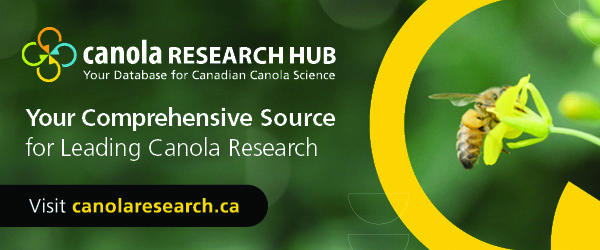Canola Research Hub has over 200 science summaries
![]()
Dive into the database at CanolaResearch.ca
today and put findings into action next growing season.
As a one-stop spot for Canadian canola science, the Canola Research Hub provides applicable agronomic insights on subjects and challenges that impact farmers.
The Hub’s comprehensive database and user-friendly interface at CanolaResearch.ca make research results easy to find and apply. For studies, users can see key findings, short summaries or full reports, and easily share results with colleagues or customers. Photos, videos, tables and graphs help relay key explanations and conclusions from the experiments and studies highlighted on the Hub.
Explore the 200+ plant establishment, genetics, nutrient, harvest and integrated pest management projects to catch up on the latest research and increase your knowledge of canola production topics. The Hub provides the science behind current best management practices for sustainable and profitable canola production in Canada. It also initiates the adoption of new practices and stimulates further innovation and discovery.
Blog posts
Monthly blogs posted on the Hub and shared on its LinkedIn account (linkedin.com/showcase/the-canola-research-hub) showcase new content and topics relevant throughout the growing season.
Here are titles and short introductions for three of my favourite blog posts from 2022:
Check more than just temperature for safe canola storage
Maintaining seed quality and avoiding spoilage are key goals of canola storage. To achieve these goals, growers need to know how seed parameters (such as oil content, quality, temperature and moisture), bin factors (bin size, fan type and size, quantity, etc.) and environmental considerations (air temperature, humidity, etc.) affect safe storage.
Check twice for improved long-term sclerotinia management
Sclerotinia stem rot is a challenge to predict and manage every year. Implementing a late summer (at 30 to 60 per cent seed colour change) field visit to rate the sclerotinia disease severity (in addition to assessing sclerotinia risk at 20 to 50 per cent flower, to make that tough spray decision) could provide a huge benefit to growers over time.
Ensure proper growth stage when lygus scouting and using thresholds
Only at certain life stages can the lygus bugs potentially cause economic damage when using their piercing and sucking mouthparts to feed on certain stages of canola crops. So it is recommended to use the new threshold of 20-30 late instar or adult lygus bugs per 10 sweeps in canola fields at the early to mid-pod stage to best manage this insect.
Find all blog posts at CanolaCouncil.org/Research-Blog/.
The Canola Research Hub is funded through the Canadian Agricultural Partnership with support from industry members like Alberta Canola, SaskCanola, Manitoba Canola Growers and the Canola Council of Canada. The site features many projects funded or administered by these organizations and is positioned to help achieve the industry goal of an average yield of 52 bu./ac. by 2025.





